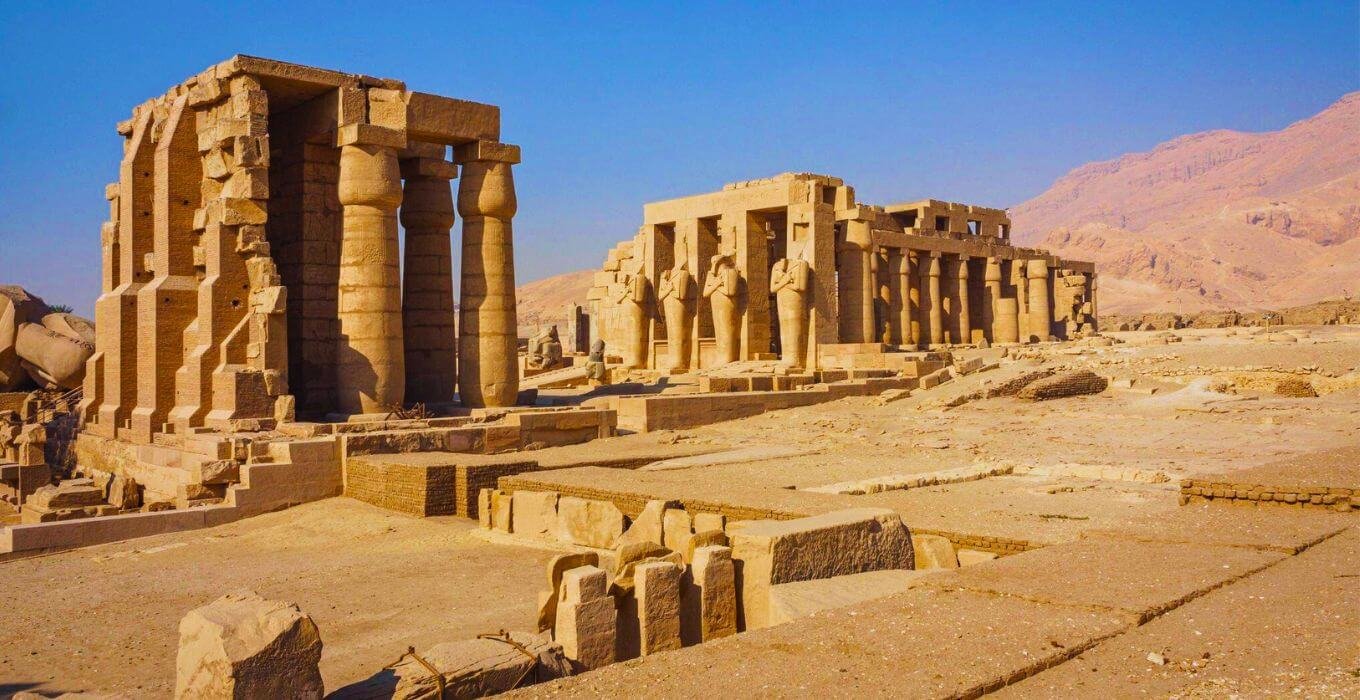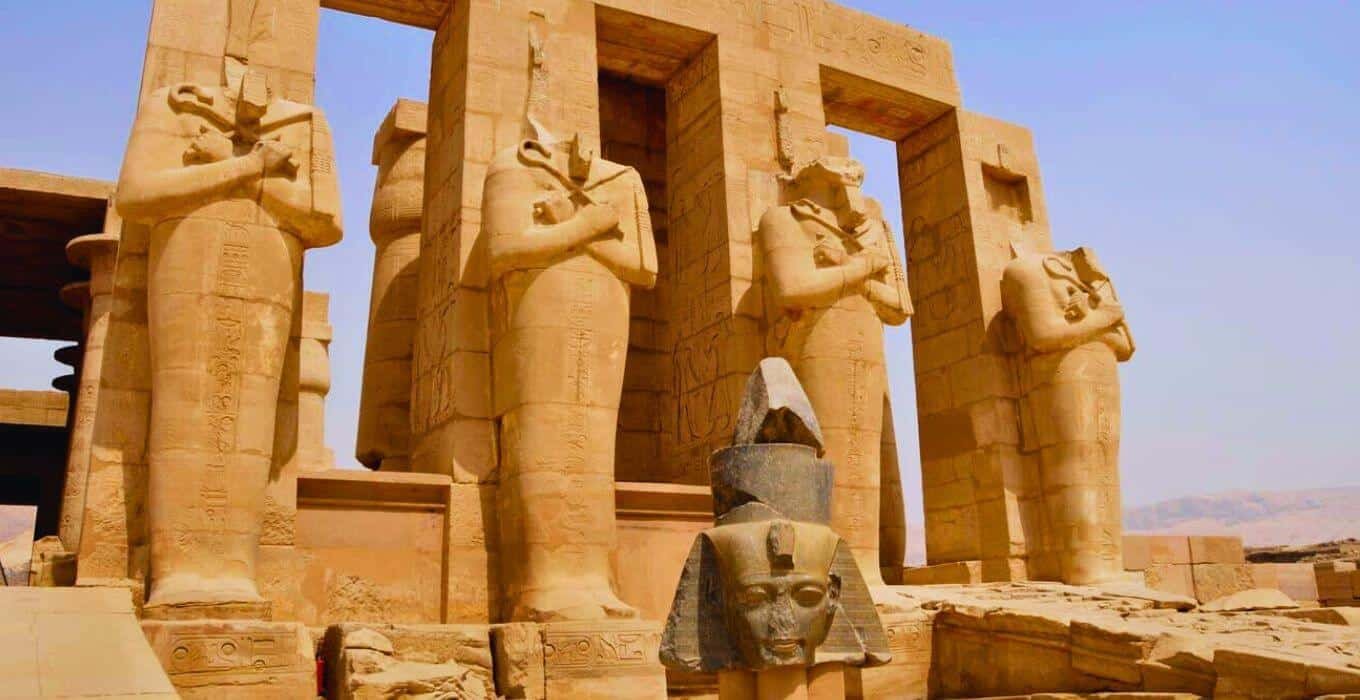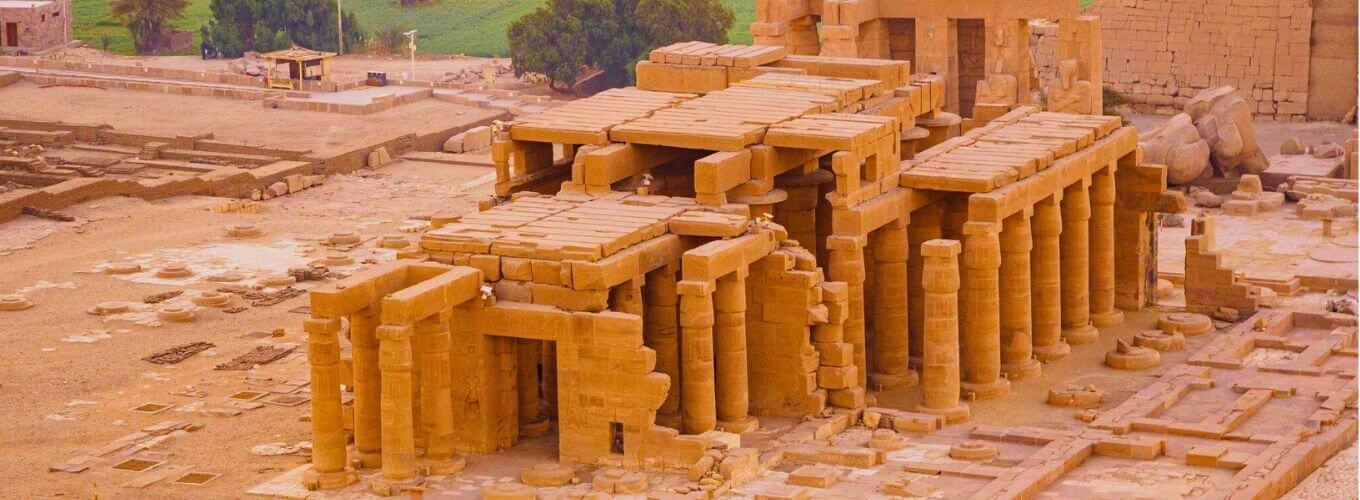What secrets hide behind the Ramesseum Temple’s massive walls? This ancient Egyptian temple is a huge tribute to Pharaoh Ramesses II. It’s located on the west bank of the Nile River in Luxor. It shows the greatness and creativity of the Ramesside period.
The Ramesseum is one of Egypt’s biggest temples. It gives visitors a special look at the ancient world’s architecture and culture.
Key Takeaways
- The Ramesseum Temple was the mortuary temple of Pharaoh Ramesses II, one of the most influential kings of the New Kingdom of Egypt.
- Constructed during the 19th dynasty around 1250 BCE, the temple features towering colossal statues, intricate carvings, and well-preserved architectural elements.
- The temple is part of the Theban Necropolis, a UNESCO World Heritage Site that showcases the magnificence of ancient Egyptian civilization.
- Ramesses II sought to immortalize his achievements and divine status through the construction of this grand temple complex.
- The Ramesseum Temple serves as a gateway to understanding ancient Egyptian religious beliefs, medical practices, and economic systems.
The Grandeur of Ramesseum Temple
The Ramesseum Temple is on the Nile’s western bank near Luxor. It shows ancient Egypt’s architectural skill and grandeur. Built in the 13th century BC, it impresses with its tall pylons and colossi of Memnon statues of Ramesses II.
Walking in, you see amazing carvings and hieroglyphic inscriptions everywhere. The walls, columns, and rooms are filled with them. They show Ramesses II’s battles, religious acts, and offerings to gods, giving a peek into ancient Egyptian history and beliefs.

Colossal Statues and Intricate Carvings
The temple’s architectural design is incredible. It has a big hypostyle hall, a sacred room, and chapels for gods. The Ramesseum’s size and detail amaze, showing the power and glory of ancient Egypt.
- The Ramesseum Temple is the second-largest temple in all of Ancient Egypt.
- The construction of the temple took more than 20 years to complete.
- The temple features a colossal statue of Ramesses II that was nearly 20 meters (65 feet) tall.
- The hypostyle hall of the temple has 48 papyrus-shaped columns in six rows.
The Ramesseum’s greatness isn’t just in its design. It also has a mortuary temple for Ramesses’ ancestors. This complex, with its detailed carvings, huge statues, and sacred areas, shows the lasting legacy of ancient Egyptians. It has a big impact on the Theban Necropolis.
Ramesseum Temple: A Journey Through Time
The Ramesseum Temple is a lasting symbol of Ramesses II’s legacy in ancient Egypt. Built during his 66-year rule, it was meant to honor him forever. It was a place for eternal worship and remembrance.
Over the years, the Ramesseum has seen many changes. Dynasties rose and fell, and ancient Egyptian culture evolved. It was used for many purposes, from a temple to a quarry and even a Coptic church. This shows how the Theban Necropolis has changed over time.
Visitors to the temple can picture the lively ceremonies and rituals that once happened here. It connects them to the Ramesside Period and Architectural History. The Ramesseum’s story is a testament to Ramesses II‘s lasting impact and the strength of ancient Egyptian culture.
|
Key Facts about the Ramesseum Temple |
Details |
|
Location |
Theban Necropolis, Upper Egypt |
|
Construction Period |
Ramesses II’s 67-year reign (1279-1213 BC) |
|
Purpose |
Mortuary complex for Ramesses II |
|
Size |
Colossal statue of Ramesses II was 19 meters high, one of the largest in Egypt |
|
Later Uses |
Quarry, Coptic Christian church |
|
Current Status |
Partially preserved, excavated since 1991 |
The Ramesseum Temple’s history is a fascinating journey through time. It shows the lasting impact of Ramesses II and the growth of ancient Egyptian culture. As researchers learn more, the Ramesseum remains a captivating place for those interested in the Ramesside Period and the Architectural History of the Nile Valley.
Architectural Marvel of Ancient Egypt
The Ramesseum Temple is a marvel of ancient Egyptian architecture. At its heart is the hypostyle hall, a vast space with towering columns and intricate carvings. These columns, shaped like papyrus and adorned with reliefs, offer a stunning visual experience.
The temple complex also includes a sacred sanctuary. This space was dedicated to the worship of gods and Ramesses II. It shows the spiritual beliefs and practices of ancient Egyptians. The Ramesseum’s architecture is a blend of elements, creating a stunning temple complex that amazes visitors worldwide.
The Hypostyle Hall and Sacred Sanctuary
The hypostyle hall is a remarkable part of the Ramesseum. It has 48 massive columns over 60 feet tall. These columns, with intricate carvings, create a sense of grandeur.
Behind the hypostyle hall is the sacred sanctuary. It was for worshiping gods and honoring Ramesses II. The temple’s design is a mix of scale, symmetry, and symbolism.
The temple’s size is impressive, with a main entrance 60 feet tall and 90 feet wide. Its enclosure wall is around 105 meters on each side. The hypostyle hall and sanctuary offer a sense of reverence and worship.
The Ramesseum Temple showcases ancient Egyptian architecture’s lasting legacy. It is a wonder of the ancient world, a testament to the builders’ skill over 3,000 years ago.
Ramesseum Temple: A Gateway to Ancient Beliefs
The Ramesseum Temple was more than a grand monument. It was a gateway to the rich world of ancient Egyptian religion and practices. Dedicated to the Theban triad – Amun, Mut, and Khonsu – it was a center of rituals and offerings to the gods.
Priests in the temple performed ceremonies, offering prayers and tributes to the gods. The temple’s inscriptions and carvings show these religious practices. They highlight the gods’ central role in ancient Egyptian life. The Ramesseum was also believed to be the pharaoh’s afterlife home, showing the deep connection between mortals and the divine.
The Ramesseum Temple gives us a glimpse into the beliefs of ancient Egypt. It shows the worship of the Theban triad and the rituals and offerings made there. This temple is a testament to the spirituality that filled ancient Egyptian life.
|
Noteworthy Temples in Ancient Egypt |
Key Features |
|
Mortuary Temple of Amenhotep III |
Largest mortuary temple ever built, measuring approximately 100m by 600m. |
|
Mortuary Temple of Hatshepsut |
The only royal funerary temple from around 1490 B.C. to remain in good condition. |
|
Mortuary Temple of Seti I |
Used for the worship of the god Osiris, built with limestone and featuring a grand hypostyle hall. |
|
Mortuary Temple of Hawara |
Considered one of the wonders of the world in Late Antiquity, with dimensions of about 120m by 300m. |
|
The Ramesseum |
Built by Ramesses II, featuring a 20-meter statue of the pharaoh and measuring 210 by 178 meters. |
“The Ramesseum Temple offers visitors a window into the profound and multifaceted beliefs that guided the ancient Egyptian civilization.”

Immortalizing a Legacy: Ramesses II and the Ramesseum Temple
The Ramesseum Temple is a lasting tribute to Ramesses II, a legendary pharaoh of ancient Egypt. He ruled for 66 years, expanding his empire and building grand structures. He also became a god in the eyes of his people.
This temple was built to honor Ramesses II after his death. Its walls show his military wins, his faith in gods, and his kindness as a ruler. These images keep his legacy alive for future generations.
By building this massive temple, Ramesses II made sure his name and deeds would be remembered. This solidified his place as a key figure in ancient Egyptian history.
|
Architectural Achievements |
Military Campaigns |
Legacy Preservation |
|
|
|
The Ramesseum Temple shows Ramesses II’s lasting impact on the world. It reminds us of the greatness of the Ramesside Period in ancient Egypt.
Exploring the Theban Necropolis
The Ramesseum Temple is part of the Theban Necropolis, a UNESCO World Heritage Site. It gives us a deep look into ancient Egyptian culture. This site is filled with temples, tombs, and monuments, showing the culture, religion, and economy of ancient Egypt.
The Ramesseum Papyrus and Granaries
The Ramesseum Temple is famous for the Ramesseum Papyrus. It’s a collection of ancient medical texts. The temple’s granaries and storehouses also show its economic role, feeding workers and dependents.
Visitors to the Theban Necropolis find many ancient Egyptian artifacts. These artifacts help us understand this civilization. From the Valley of the Kings to the Tombs of the Nobles, we learn about the economic importance and culture of the Theban Necropolis.
|
Key Facts about the Theban Necropolis |
Details |
|
Number of Tombs in the Valley of the Queens |
Nearly 80 |
|
Accessibility of Queen Nefertari’s Tomb |
Only accessible to VIP groups due to fragile state |
|
Tombs of the Nobles |
Feature vivid paintings on stucco due to inferior limestone for reliefs |
|
Tomb of Ramose, Vizier and Governor of Thebes |
Captures the transition from Amun- to Aten-worship through reliefs |
|
Duration of the Day Tour |
6 hours |
|
Tour Type |
Egypt Private Tours |
|
Number of Key Sites Visited |
4 (The Ramesseum, Tombs of the Nobles, Medinet Habu, Temple of Amun) |
Visitors to the Theban Necropolis see the beauty of ancient Egyptian artifacts. They learn about the economic importance of this civilization.
Conclusion
The Ramesseum Temple is a symbol of ancient Egypt’s lasting impact. Built by Pharaoh Ramesses II, it shows the power, creativity, and faith of that time. Its massive statues, detailed carvings, and preserved architecture amaze everyone who sees it.
Located in the Theban Necropolis, a UNESCO World Heritage Site, the Ramesseum is a treasure for scholars and travelers. It has survived for centuries, sharing the secrets of ancient Egypt. This temple reminds us of Egypt’s strength and cultural importance.
Seeing the Ramesseum Temple is like traveling back in time. It lets us experience the grandeur and depth of ancient Egypt. This temple, with its stunning architecture, shows the lasting influence of Egyptian culture on today’s world.
Read other related articles:
